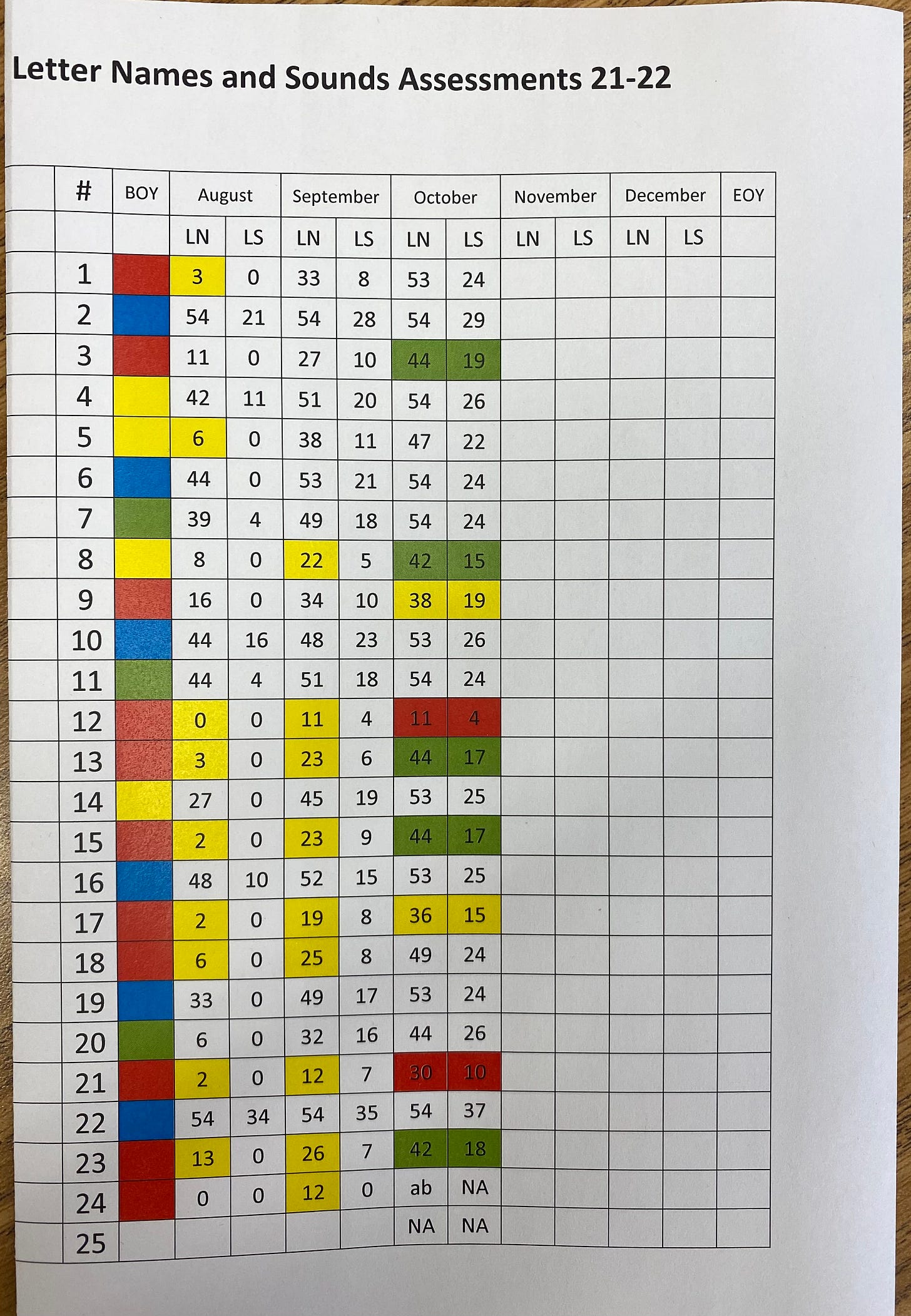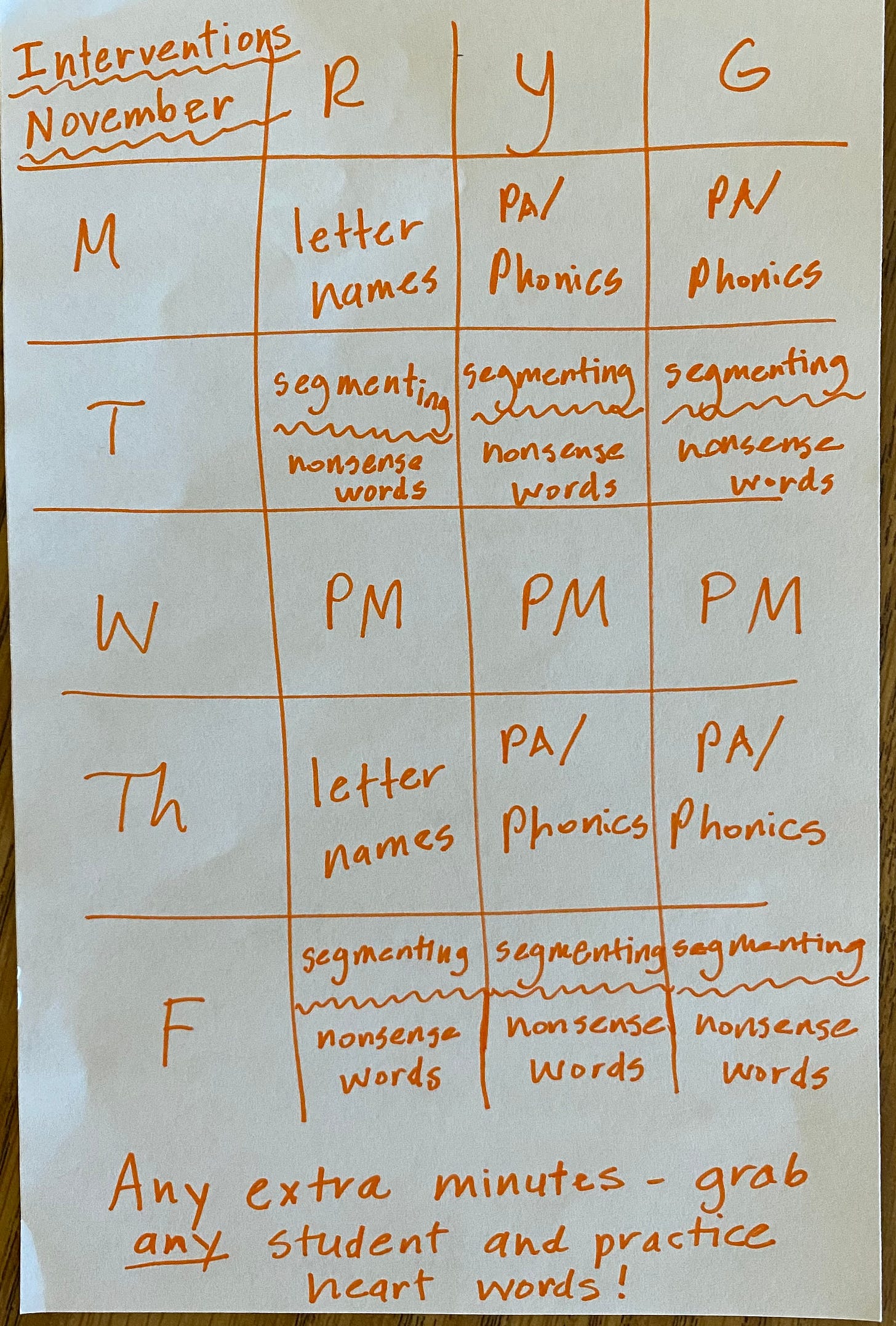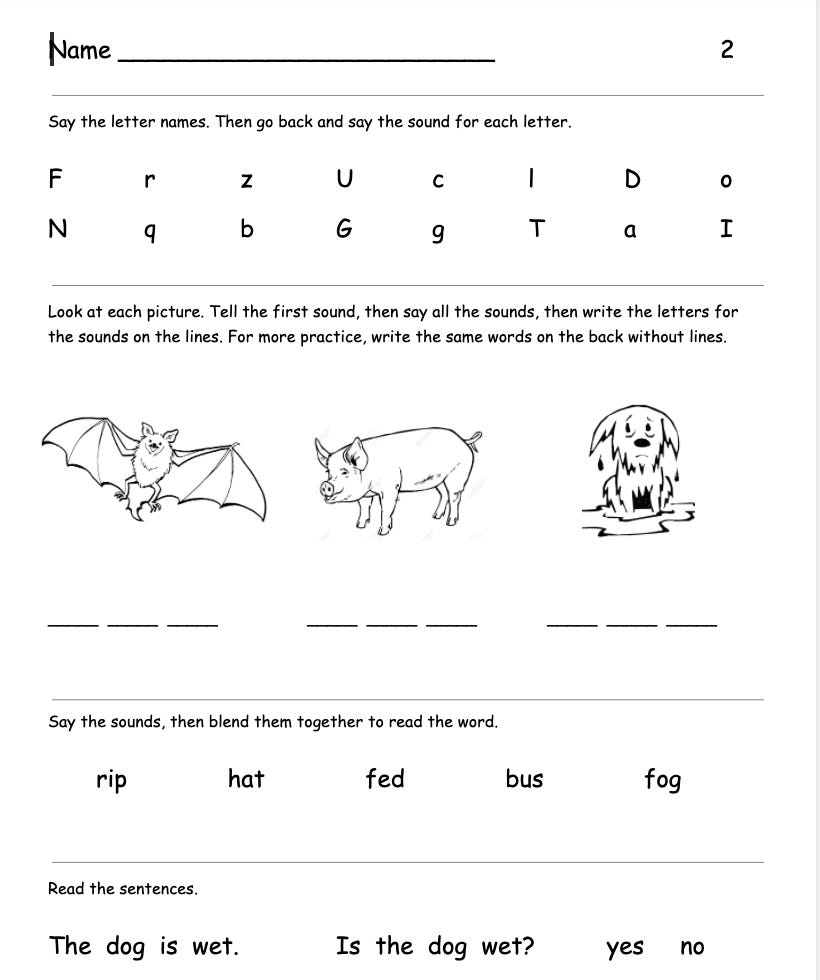November is a good time to take a look at student growth—both individual growth and overall growth of the class—and to think about whether your phonics instruction is working. The easiest and most useful data for me to collect throughout the fall is the number of letter names and letter sounds students know. I start in August when students come for their assessment appointment before school even begins. Then, I retest at the end of September, the end of October, the end of November, and possibly again before we leave for Winter Break. My data is shown here.

What does my data tell me?
First, I look across the rows at individual student growth. I am quite pleased with the growth that each student has made, especially some of those that I was working with during the daily intervention time.
For example, students 1, 5, and 18 gained so many letter names and sounds—and are applying them to reading VC and CVC words—that I dismissed them for now from interventions.
Students 3, 8, 9, 13, 15, 17, and 23 (those highlighted yellow and green) also made good growth. If they were in another class with more needy students, they might not receive any additional extra support. But I am going to keep working with them to make sure their growth continues.
Students 12 and 21 (highlighted red) did not show a lot of growth and will definitely continue to get daily interventions with letter names and sounds.
The rest of the students are growing at a steady pace and, equally important, applying the sounds they know to their reading and writing. Overall, the class is in good shape, in my opinion, for early November and I am pleased with the effectiveness of my phonics instruction, including the systematic and explicit whole group phonics we do every day, the supplemental small group activities where students practice applying what they’re learning, and the interventions I am doing with those who came in knowing very few letters.
I’ve been gathering data like this for many years and it does always show that my method for teaching phonics works. But this year, the data is even better, and I attribute that to the changes I have made in my small group instruction based on the learning I’ve done around the science of reading. To sum up those changes, I started students on blending sounds much earlier than in past years. This was possible because I taught them to blend VC words first before attempting CVC words and, wow, what a difference that made. About 2/3 of my class can already read CVC words. Most of them were able to transition easily from reading VC words to CVC words; those who didn’t, did not or will not struggle for long, I can already tell. Of course, I have a few students who are still working on their VC words and who will have a harder time with everything.
In comparing this year’s data with data from past years, this class knows way more letter sounds in October than any class of mine ever did before. My whole group phonics instruction hasn’t changed much (it’s always been systematic and explicit), but I am having students put those letter sounds to use much earlier this year and that is why they are learning the sounds faster and retaining so many of them!
What is your data telling you?
It’s a good time to take a look at your data. Your students have been with you for two-to-three months now and we’re getting toward the middle of the school year. Is what you’re doing working? Are students growing? Sometimes we have a tendency to think or imply that students just aren’t learning, that they’re not ready, that they’re not picking up on what we’re teaching. We must, however, remove the blame from the students and try to put it back on ourselves. What can we do differently? Does it make sense to continue with what you’ve been doing or is it time to make some changes?
If we teach it but the students don’t learn, is it really called teaching?
What works in my classroom
These are the things I’m doing to ensure growth in letter names, letter sounds, and students putting this knowledge to use for real reading and writing.
15-20 minutes of daily whole group phonics. We have just finished learning all 26 letter names and sounds. Each letter/sound has an action or a focus on mouth position and students use these when reading VC and CVC words (for example, they’ll make a nest with their hands for the letter n or point to their throats for the letter g). We review all letter names and sounds each day and I insist on full participation.
Whole group phonics also includes phonemic awareness training in first sound fluency, blending, and segmenting using the focus sound of the day.
We review letter names and letter sounds during small group instruction and we practice reading VC and CVC word lists. The word lists I created and the way I ordered them to build upon each other are proving invaluable. It makes me wonder how I every taught students to read before I had these lists. Much of the class is now starting to read continuous text (sentences) too.
Small group instruction also includes lots of phonemic awareness.
Students put their letter sounds to use during our daily 25-minute writing period.
Writing time also involves phonemic awareness.
I have a daily 35-minute intervention time where I work with approximately 9 students on letter names. This month—November—I am also incorporating letter sounds, phonemic awareness, segmenting to write CVC words, and blending to read CVC words. I have different levels of intervention students now and thus differentiated instruction. I have mapped it out here.
PA/Phonics means that I will use these type of sheets (see below). They usually last for a week since we can practice much of what is on it over and over again. I made these last year and they were quite useful in bumping my lowest readers up to grade level. Last year, I started using them in February; this year it’s October because the students—even my lowest—are that much further along because of the changes to my small group instruction.
On the handwritten interventions plan sheet above, the PM stands for DIBELS Progress Monitoring, which I try to do every Wednesday. I really don’t use it for progress monitoring (I already know where these kids are and their strengths and weaknesses); rather, I use it as a teaching tool. I am currently progress monitoring on first sound fluency. If a student doesn’t respond correctly, I mark it wrong and then take two seconds to model the correct response. So, I am teaching as well as fulfilling a district progress monitoring requirement.
We all have different students and different teaching situations. Many of you, I know, don’t have a lot of flexibility in the materials or programs you have to use. Some of you do not have a classroom aide or anyone to help out with interventions. But most of us are working toward the same goals with our students. If you think it’s time to make some changes in your phonics instruction or just need or want more ideas, there are many more blog posts and videos and materials available from me with the paid subscription. Think about it. You can always try it for a month or two.
If you have any questions or want additional information, please comment below so others may benefit from the discussion as well. Thank you!






Once again, you continue to amaze and inspire ALL of us!! It is obvious that all the "little" things. you do are paying off with big rewards!! Do you have a template of this chart you could share with us? Thank you!!